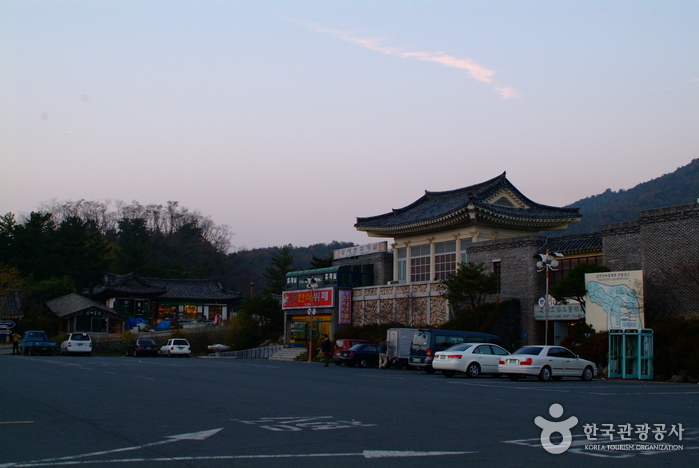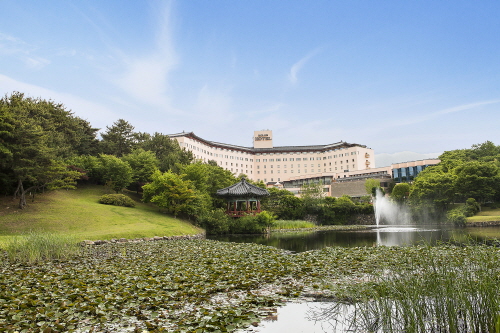Gyongju Folk Craft Village (경주민속공예촌)
14.7 Km 34877 2024-02-27
230 Bobul-ro, Gyeongju-si, Gyeongsangbuk-do
Gyeongju Folk Craft Village, nestled at the foot of Tohamsan Mountain in Gyeongju, is a traditional folk craft village consisting of around fourty Korean traditional houses including thatched-roof and tiled-roof houses. Skilled artisans proficient in traditional arts and crafts gather here to produce and sell ceramics, woodcrafts, jewelry, hanbok, stone crafts, and more. Visitors can also participate in hands-on crafting experiences. The village's Silla Art and Science Museum showcases artifacts from the Silla dynasty, while nearby attractions include the Bomun Tourist Complex, Bulguksa Temple, and Seokguram Grotto.
Hyangdan [Korea Quality] / 향단 [한국관광 품질인증]
14.8 Km 42644 2023-09-05
121-83 , Yangdongmaeul-gil, Gyeongju-si, Gyeongsangbuk-do
+82-10-6689-3575
Hyangdan in Yangdong Village, Gyeongju, Gyeongsangbuk-do, is a grand old house designated as a national treasure, having been built by King Jungjong for the elderly mother of his courtier Yi Eonjeok. Much of the original 99-kan house was destroyed during the Korean War and the rest converted to a guesthouse. Visitors can stay in the anchae, haengnangchae and an annexe - which all appear to be different x_heights because of the upward slope of the site. Various experience programs are offered: woodblock printing, a tea ceremony, natural dyeing, and traditional etiquette.
Cheonggong [Korea Quality] / 청공한옥 [한국관광 품질인증]
15.8 Km 9380 2020-09-08
5-6, Igu 2-gil, Gyeongju-si, Gyeongsangbuk-do
+82-10-4577-5223
Cheonggong Hanok is a mere 10 minutes away from Bulguksa Station (Donghae Line) on foot. The two traditional Hanok buildings house 10 rooms. Once you enter the main gate, the harmonious scene of a big grassy yard, a very old pine tree, a small pond, and the graceful Hanok buildings welcomes you. The garden looks a bit exotic, but there is a back story to it. The first architect of the house did business in Japan with his wife living alone in Gyeongju but regretted not having spent a long time with her; thus, he came back to Korea, built the biggest house possible, and lived with his wife for the rest of his life. Afterward, his descendants took over it, named it after the architect, Cheonggong, and opened it as a Hanok stay. That is how the space where Korea’s traditional Hanok and Japanese garden were put together by the Korean architect who did an extended stint in Japan came to be. The table used by the couple is preserved in the garden for guests to look at. Although it is a traditional Hanok, every room is equipped with a TV, a refrigerator, an air-conditioner, and a bathroom to make the space comfortable to stay even for children.
GyeongjuCheonnyeonhanok Pension [Korea Quality] / 경주천년한옥펜션 [한국관광 품질인증]
15.8 Km 9165 2020-09-09
86-61, Sidong-ro, Gyeongju-si, Gyeongsangbuk-do
+82-10-9898-3995
Cheonnyeon Hanok Pension, located in Sirae-dong, Gyeongju-si, Gyeongsangbuk-do, was newly opened in April 2014. The owner discovered this geomantically ideal site, with a mountain to its rear and a river to its front, and constructed a 238m2 hanok on a 1,778m2 plot of land. The hanok is a ‘ㄱ’-shaped structure consisting of two floors above ground, with the guest accommodation situated on the first floor. The pension was named ‘Cheonnyeon Hanok’ to represent the owner’s wish that the house be preserved for over a thousand years (“cheon nyeon”). It is set amid a beautiful landscape and commands an open view of the nearby pine grove, a large pond, fields, and Tohamsan Mountain. The house is built of pine wood and red clay, and features an eco-friendly geothermal floor heating system and double-layered doors to keep out drafts. Although the outer yard is covered with gravel, the spacious grassy inner courtyard of the bonchae building is equipped with benches, and serves as both a playground for children and a relaxing space for adult guests. The garden is notable for its well-tended flowers and trees. The pension has 6 guestrooms including four single rooms (23m2); one room (29m2) with a numaru (upper floor) that can accommodate 3 to 5 people; and a two-room (46m2) suite that can accommodate 4 to 10 people. Maehwa-bang (single room) is characterized by rafters and a ‘井’-framed ceiling; Mogryeon-bang (two rooms) is a large guestroom that can accommodate two to three families, and has a sliding door in the middle for convenient use of the space; and Yeonggot-bang has an upper floor equipped with a BBQ facility. Large family groups tend to rent the Yeonggot-bang and an additional room. Other guests can also use the separate BBQ site in the courtyard. (Grill and charcoal: KRW 15,000 per 4 persons) Each room has a pleasant, clean interior and is equipped with a TV, fridge, air-conditioner, bathroom, sink, electric rice cooker, kettle, induction plaque, and Internet. The pension boasts a beautiful nighttime view of Joyang Reservoir, Tohamsan Mountain, and a pavilion of Bulguksa Temple. Guests can enjoy fishing in the reservoir and walking up the low mountain or strolling along the path through the pine grove. The pension also offers various folk games including Tuho (Arrow-throwing), Jegichagi (Korean shuttlecock game), Yunnori (traditional Korean board game) and kite-flying free of charge. In addition, it is close to a number of Gyeongju’s major tourist attractions including Seokguram Grotto and Bulguksa Temple, and is only 20 minutes’ drive from Gampo, Jusangjeolli Cliff, and the Royal Tomb of King Muyeol. Cheonnyeon Hanok Pension is particularly popular among families and groups.
Kolon Hotel Gyeongju (코오롱호텔)
16.6 Km 16302 2021-04-15
289-17, Bulguk-ro, Gyeongju-si, Gyeongsangbuk-do
+82-54-746-9001
Kolon Hotel Gyeongju is located in front of Bulguksa Temple, one of the world’s top ten historic sites. The building features arch-shaped fortress wall with spacious areas, designed with both traditional and modern elements. As a recuperation hotel, it houses a spa using sodium bicarbonate water, and a 9-hole public golf course. It offers a cozy ambience and sincere service with varied facilities including pleasant guestrooms viewing the sunrise of Tohamsan Mountain, sports facilities for golf, swimming, jogging and spas. It is the only premium-class hotel in Gyeongju to have hot spring spa facilities. The lobby on the third floor is famous for the lounge where people can enjoy the panoramic scenery of Tohamsan Mountain while relaxing, as well as a coffee shop serving various drinks and a luncheon over live music.
Gyeongju Bulguksa Temple [UNESCO World Heritage] (경주 불국사 [유네스코 세계문화유산])
17.2 Km 241163 2023-01-03
385, Bulguk-ro, Gyeongju-si, Gyeongsangbuk-do
+82-54-746-9913
Bulguksa Temple is a representative relic of Buddhist culture from the Silla kingdom. The temple was built during the 15th year of King Beopheung's reign (514-540) to wish for peace and prosperity for all. It was later rebuilt in 751 by Kim Dae-seong. Unfortunately, the temple caught fire during the Imjin War (1592-1598). After the war, the temple suffered serious damage and was often the target of theft.
Starting in 1920, the temple has undergone continual restoration work. The temple now holds seven national treasures and a number of additional important heritages and was designated a World Cultural Heritage Site along with the nearby Seokguram Grotto by UNESCO in December 1995.
Bulguksa Hanok Farm Stay [Korea Quality] / 불국사한옥팜스테이 [한국관광 품질인증]
17.4 Km 1 2022-04-06
5-52, Jinti-gil, Gyeongju-si, Gyeongsangbuk-do
+82-10-5489-1742
Bulguksa Hanok Farm Stay is an accommodation that offers many programs located right below Bulguksa Temple in Jinhyeon-dong, Gyeongju-si, Gyeongsangbuk-do. There is a total of four guest rooms. Every guest room has a bathroom and a kitchen inside. You can also cook in the rooms as they are equipped with cooking appliances such as a rice cooker, microwave, and electric stove. Ouga is a double-story unit, and the guest rooms on the first floor and the second floor are rented separately. On the first floor, there is an ondol room big enough for four people, and the ondol room on the second floor is big enough for three people and has a nice view. Both rooms have a terrace where guests can enjoy a barbecue grill. Bogyeonga also has two guest rooms that are rented separately. All of the rooms are ondol type rooms. In the Bogyeonga building, only room 1 has a double-story structure. Guests staying in the Bogyeonga building can have a barbecue grill in the terrace. A well-maintained garden is surrounding the hanok building, and there is also a 1,000-square-meter foot volleyball court in the lawn. A unique benefit of staying in Bulguksa Hanok Farm Stay is that you can participate in farming programs. You can pick apples from 400 apple trees on the farm. You can also participate in various programs themed on the food crops grown in the farm, including persimmon, quince, blueberry, lettuce, and tomato. Nearby tourist attractions include Bulguksa Temple, Seokguram Grotto, Bomun Tourist Complex, Donggung Palace and Wolji Pond, Cheomseongdae, and Woljeonggyo Bridge in Gyeongju. California Beach (water park) is also closeby.
Oeosa Temple (오어사(포항))
17.8 Km 38520 2023-01-25
1 , Oeo-ro, Nam-gu, Pohang-si, Gyeongsangbuk-do
+82-54-292-2083
Oeosa Temple in Unjesan Mountain is a place where the deep scent of Buddha can be felt with a lake that looks like a dragon wrapped around it and the strangely-shaped cliffs which harmonizes like an oriental painting. Oeosa Temple is a sacred place where the four great patriarchs of Silla were born. This temple was built during the reign of King Jinpyeong (579-632), the 26th ruler of Silla. It was originally called Hangsasa Temple, but when Great Master Wonhyo and Zen Master Hyegong practiced religious asceticism here, a contest was held to revive the fish in the stream with religious power. However, one of them did not survive, and the other did and swam vigorously.
So each argued that he himself saved the fish, so they called it Oeosa Temple by writing the characters 'O' and 'Eo.' Daeungjeon Hall has a hip-and-gable roof with three bays in the front and two in the side. It was rebuilt in the 17th year of King Yeongjo of the Joseon dynasty (1741). Around the temple, the beautiful natural scenery of Unjesan Mountain and the blue water of Oeoji are spectacular. Jajangam Hermitage can be seen on the rocky cliff, and Wonhyoam Hermitage can be seen to the west of Oeosa Temple. Daeungjeon Hall (Gyeongbuk cultural heritage) has a national treasure bell, Buddhist monk Wonhyo's hat, and many other relics.
Gyeongju Seokguram Grotto [UNESCO World Heritage] (경주 석굴암 [유네스코 세계문화유산])
18.2 Km 137981 2023-08-24
873-243, Bulguk-ro, Gyeongju-si, Gyeongsangbuk-do
+82-54-746-9933
Seokguram Grotto was constructed by Kim Dae-Seong during the reign of King Gyeong-Deok (742-765) of the Silla Kingdom. Located 3 kilometers away by hiking trail and 9 kilometers by car from Bulguksa Temple, the grotto was designed very harmoniously with the seated Buddha facing the East Sea. It is a valuable cultural heritage that is preserved and registered as a UNESCO World Heritage on December 6, 1995.
Yeongil Bay Hot Springs (영일만온천)
18.2 Km 22503 2020-03-18
21, Unje-ro 386beon-gil, Nam-gu, Pohang-si, Gyeongsangbuk-do
+82-54-285-0101
The construction of this huge hot spring complex started in Yeongil Bay in 1988 after it was found that Yeongil Bay has the highest geothermal heat in Korea while drilling for oil in 1974.
The water’s main ingredients contain healthy minerals such as calcium, natrium, fluorine, magnesium, chlorine, sulfuric acid, fluorine, zinc, germanium and radium. Yeongil Bay Hot Springs maintains its water with alkali bicarbonate at a pH of 9.43. The temperature of the water is somewhat low though at 35℃.
The hot springs help to recover from fatigue, to help beauty care, anti-aging, neuralgia, heart disease, and liver functions. The water here also has a very unique texture.

![Hyangdan [Korea Quality] / 향단 [한국관광 품질인증]](http://tong.visitkorea.or.kr/cms/resource/26/2998926_image2_1.jpg)
![Cheonggong [Korea Quality] / 청공한옥 [한국관광 품질인증]](http://tong.visitkorea.or.kr/cms/resource/69/2637169_image2_1.jpg)
![GyeongjuCheonnyeonhanok Pension [Korea Quality] / 경주천년한옥펜션 [한국관광 품질인증]](http://tong.visitkorea.or.kr/cms/resource/35/2635535_image2_1.jpg)


![Bulguksa Hanok Farm Stay [Korea Quality] / 불국사한옥팜스테이 [한국관광 품질인증]](http://tong.visitkorea.or.kr/cms/resource/33/2813933_image2_1.jpg)
 English
English
 한국어
한국어 日本語
日本語 中文(简体)
中文(简体) Deutsch
Deutsch Français
Français Español
Español Русский
Русский